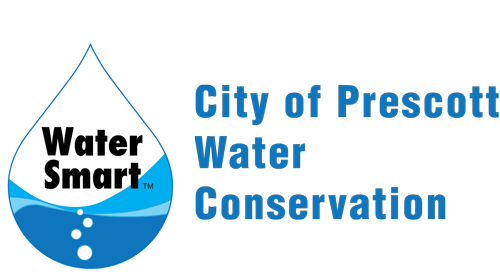Rainwater
harvesting
Optimize Natural Resources
Rainwater Harvesting
Rainwater Harvesting has many benefits besides reducing the use of potable water for outdoor irrigation. City water customers can use the City’s Water Conservation Rebate program to install active or passive rainwater harvesting at their home or business.
rainwater harvesting
Passive vs. Active
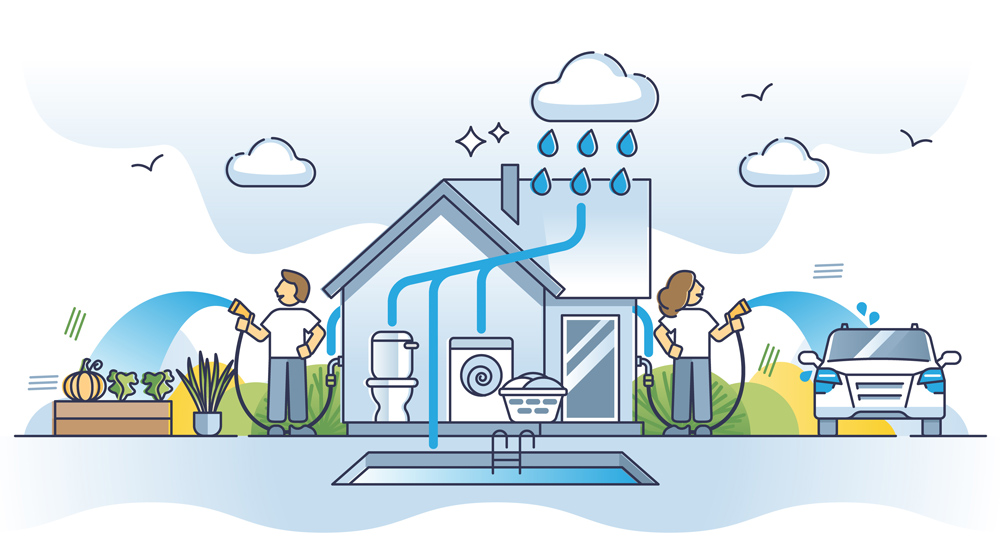
Passive
A simple rainwater harvesting method that diverts precipitation from gutters directly onto landscaping.
This method is low maintenance, can be beneficial for people on a budget, or where site restrictions exist. Please see our Homeowners Guide if you are interested in installing a passive rainwater harvesting system in your yard, plus links to additional resources.
Active
Active rainwater harvesting conveys water from the roof of your home into a tank or cistern.
Elaborate systems can be installed that include distribution systems. Leaf screens and first-flush devices are important for installation. This supply is ideal for watering vegetable gardens, raised planter beds, and containers of indoor plants.
Rain Gardens
a how-to manual for homeowners
A complete guide to the set-up and maintenance of Rain Gardens for home owners.
rainwater harvesting
FAQ & Tips
By Fred Oswald, Citizens Water Advocacy Group
Why should I harvest rainwater?
About 30 percent of our water in Prescott is used for landscaping. We can save this precious water by replacing thirsty vegetation with drought-tolerant plants and by irrigating with rainwater harvested and stored in rain tanks and/or passively capturing water in a shallow basin or rain garden and allowing it to percolate into the ground.
You can harvest rainwater from even a very slight rain shower. The first ½ mm just wets the roof and is lost but after that, every ½ mm produces about 10 gal. of water (depending on roof area). Thus 5 mm, if captured in 4 tanks at the corners of your house, yields 4*10*(5-½) = 180 gal. And this is from a very light rain! A 1,000 square foot roof can collect 11,000 gallons over a year in Prescott. You can passively harvest even more rainwater from your lot: A small 6,500 square foot lot receives 72,000 gallons of water a year.
In addition to saving water and money, rainwater is free from chlorine and salts, which makes it ideal for watering flowers and vegetable gardens. You can supplement harvested rain by saving water used to wash fruits and vegetables: catch it in a bowl and pour it on your plants.
How can I collect rain from my downspouts into containers? Is that easy?
Rain barrels come in various sizes from about 50 to well over 1,000 gallons. Smaller barrels, which can be “daisy chained” to provide more storage, can be purchased from stores or online and low-cost barrels can be made from used plastic food-grade drums. The City of Prescott requires a minimum of 100 gallons of total storage capacity.
Where do I store rainwater? Are there inexpensive containers?
For a small inexpensive system, I recommend 50-60 gallon used food barrels such as the paintable containers shown in Fig. 1. These sell for about $40 including a small spigot (that you may want to replace) at the C-A-L Ranch store, 1048 Willow Creek Rd, Prescott. My house has 10 rain barrels with a total capacity of about 550 gallons.
You may find free used barrels from a food processor or soft drink bottler. I do not recommend rain barrels that take water through a screen at the top of the barrel (Fig.2). If the screen is coarse, mosquitos can enter and breed. A fine screen will clog and dump water on the ground. This barrel will overflow when it is full.

Fig 1 ─Three 50-gallon rain barrels (painted used food drums) supply water for the small garden behind. Flower pot sits on top of one barrel.
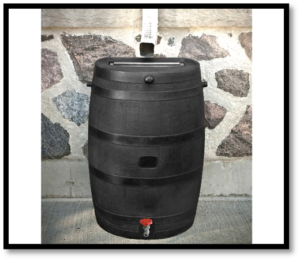
Fig 2 ─ Top-feeding rain barrel (not recommended).
What type of diverter do I need?
With small rain barrels, you can use diverters to collect water from your downspouts and send it to containers. Some rain barrels come with a rubber diverter (Fig. 3), but I do not recommend that.
If you are not concerned about overflow near your house (you probably should be!) then almost any diverter will do, including the rubber type shown in Fig. 3, which blocks ¾ of the downspout area. However, water will back up in the downspout after the barrel is full, causing overflow. In a heavy rain, water can even back up over the gutter. Also, tree leaves can block the small center opening.
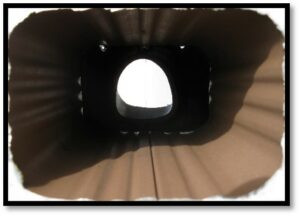
Fig 3 ─ Rubber diverter in downspout that blocks ¾ of its area. Note small opening for passing water.
An effective diverter not prone to overflowing the barrel (but should be sealed to prevent leaking) is the Oatley Mystic Rainwater Collection System (Fig. 4). The supplied hose kinks where it was folded for shipping. The Oatley does not include an inlet fitting for the barrel. I suggest mounting the Oatley diverter at the same height as the barrel fitting, not 12” higher as the instructions say, unless the barrel is sealed and you provide an air vent hose extending above the diverter.
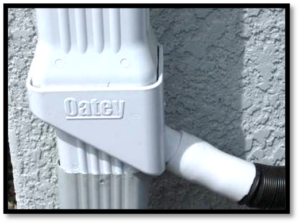
Fig 4 ─ Oatley Mystic Diverter.
Another effective diverter, though somewhat expensive, is the Fiskars DiverterPro (Fig. 5) which does not overflow and works well if you make some simple modifications. The diverter was available for a $12 discount at online retailers but seems now to be available only from Fiskars at full list price.
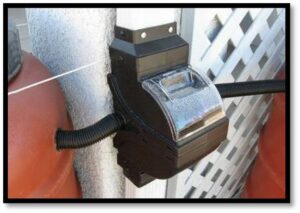
Fig 5 ─ Fiskars DiverterPro feeding two rain barrels (since painted).
Modifications: Mount your barrel on a base (such as concrete blocks) to provide room to get a bucket under the spigot at the bottom of the barrel (see Fig. 6). Hold the diverter up to the downspout with the outlet at the height you want the barrel inlet, allowing 1-2” headroom in the barrel to prevent overflow. Allow ½” for the downspout to fit into the diverter and make your top cut there. Then for a DiverterPro, cut off 10.25″ for a 2×3″ (or 7.75” for a 3×4”) downspout. It’s easier to cut and fit the downspout if you remove it from the house first.
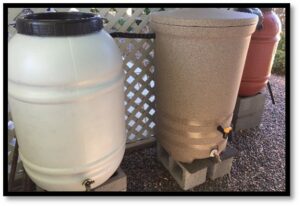
Fig 6 ─ Three rain barrels fill from one downspout. Barrel on left was painted.
After the downspout is cut, you need to shape it to flatten the fluting and square the corners. I used large linesman’s pliers for this. Take extra care fitting the bottom piece and caulk it well with silicone seal or caulk to prevent leaking (Fig. 7). Adding a screw at front and back will make it fit better.
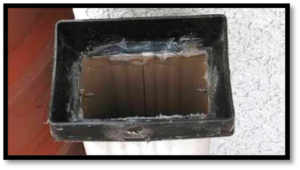
Fig 7 ─ Adapter connected to lower part of downspout. Note silicon seal.
To assemble the system, re-attach top and bottom of downspout to your gutter and drainpipe and then ease the diverter into place. Secure with screws. You should have a gutter screen above your downspout to keep leaves, etc. out of your system. Tie barrels down to keep them from blowing away.
The DiverterPro comes with one inlet fitting for the barrel and a flexible hose. Use a 1” hole saw or drill to mount the fitting. You can connect two barrels to a single diverter with another inlet fitting (Fig. 5), but these are hard to find locally. You can also use a connection kit to “daisy chain” two or more barrels together (Fig. 6). (Note painted left barrel was painted with latex house paint.)
Larger homemade systems can be made from intermediate bulk containers, which come in 175 and 275-gallon sizes or larger. These have a metal frame that reinforces a plastic container (Fig. 8). They should be painted or covered with a light-blocking fabric to prevent algae growth.
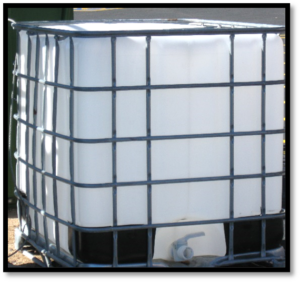
Fig 8 ─ Intermediate bulk container
Polyethylene rain barrels can be painted to match your house as shown in Figs. 1 and 6. The paint sticks better if the barrel is pre-treated by “flaming” (lightly passing the flame from a propane torch over the surface).
Larger rain tanks (Fig. 9), have two 650-gallon tanks with pumps and an overflow line. It costs about 40% more for two tanks instead of one of double size. But with two or more tanks, you can collect water from a larger part of your roof. With larger systems, you can add a pump to provide pressure and connect to an irrigation system. For containers larger than about 200 gallons, the downspout should connect directly to the container with a separate overflow.
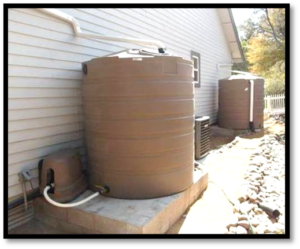
Fig 9 ─ Twin 650-gallon rainwater tanks beside Prescott home.
You can see examples of larger systems at the Adult Center of Prescott, 1280 E Rosser St. Larger systems can be purchased from and installed by Prescott companies such as Skywater and Arizona Seamless Gutters.
Water quality: A University of Texas study found that rainwater collected from asphalt fiberglass shingle roofs contains high levels of dissolved organic carbon. This is mainly a concern for potable (drinking) use. Water from a new asphalt roof may have a dark (tea) color and an odor.
What is passive rainwater harvesting?
Passive rainwater harvesting refers to the use of shallow basins in the ground designed to “slow it down, spread it out and soak it in.” Passive collection does not require gutters on the house and water can be collected from a driveway and hillside in addition to the roof. The soil can store more water more cheaply than cisterns or barrels. You can see attractive basins or swales at the Adult Center of Prescott on Rosser St. (Fig. 10) and at Prescott College on Grove Ave.
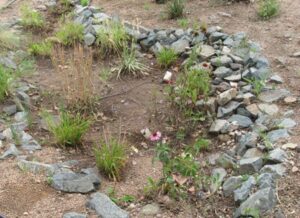
Fig 10 ─ Passive rainwater harvesting
Passive systems can also be created using small check dams in a wash or ditch. Fig. 11 shows check dams at Highlands Center. A check dam can be simply a row of stones. Dirt accumulating behind the dams grows plants. Native Americans have used check dams to grow corn.
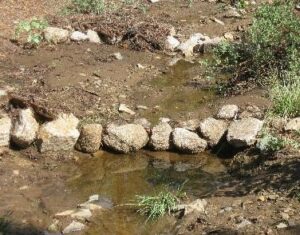
Fig 11 ─ Check dams in wash
Equally important as rainwater harvesting is landscaping with drought-tolerant plants (Fig. 12). These plants can be quite beautiful, and they are native here.

Fig 12 ─ Yellow Bird of Paradise, drought-tolerant plant, amwua.org/
The City of Prescott has updated its latest publication: Rain Gardens A How-To Manual for Homeowners. Prescott water customers should refer to this guide if they wish to receive a credit on their utility bill. A site visit must be conducted prior to beginning the project. Call 928 777 1130 for more information.
Additional Information & Ideas on larger systems
Additional information can be found on the CWAG website: HERE
This includes the booklet “Harvesting Rainwater for Landscape Use” and a “Water Budget” spreadsheet.
For ideas about larger systems, see a video of the April 2016 CWAG program, “Everything You Need to Know About Rainwater Harvesting” available HERE.
More information on passive harvesting can be found in: Rainwater Harvesting for Drylands and Beyond, vols. 1 & 2 by Brad Lancaster. Available at Yavapai County Public Library
With a little care, we can all save significant amounts of water in our homes, protect the aquifer, and save money on our water bills.
Do Your Part
Be WaterSmart
Curious if your water conservation efforts pay off? View your eligibility for incentives and rebates below.
